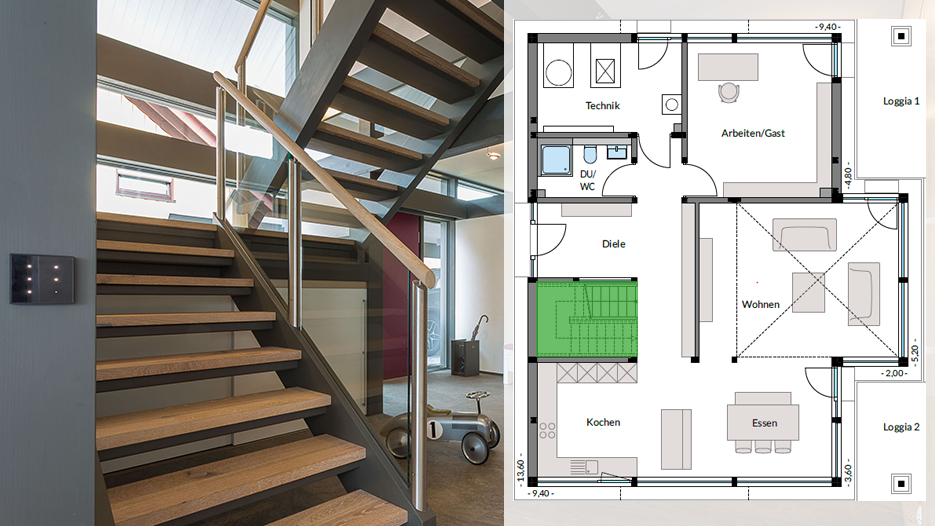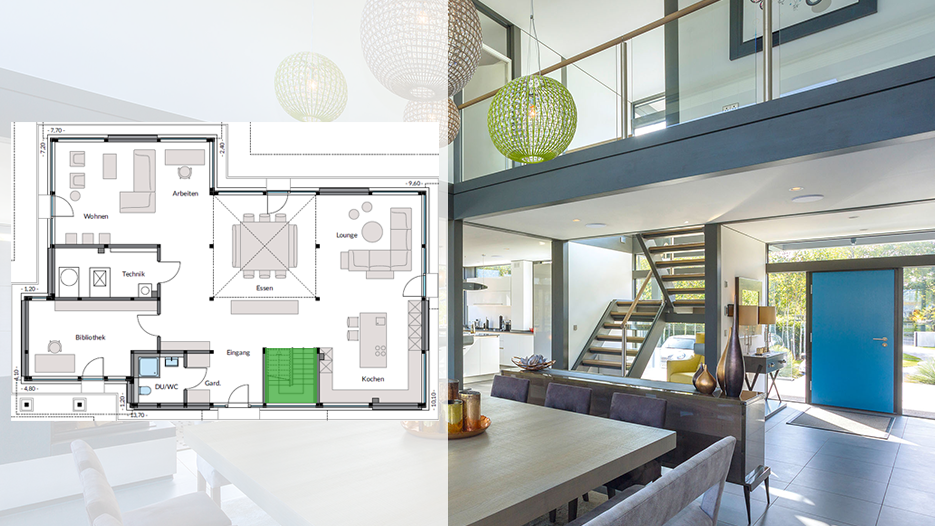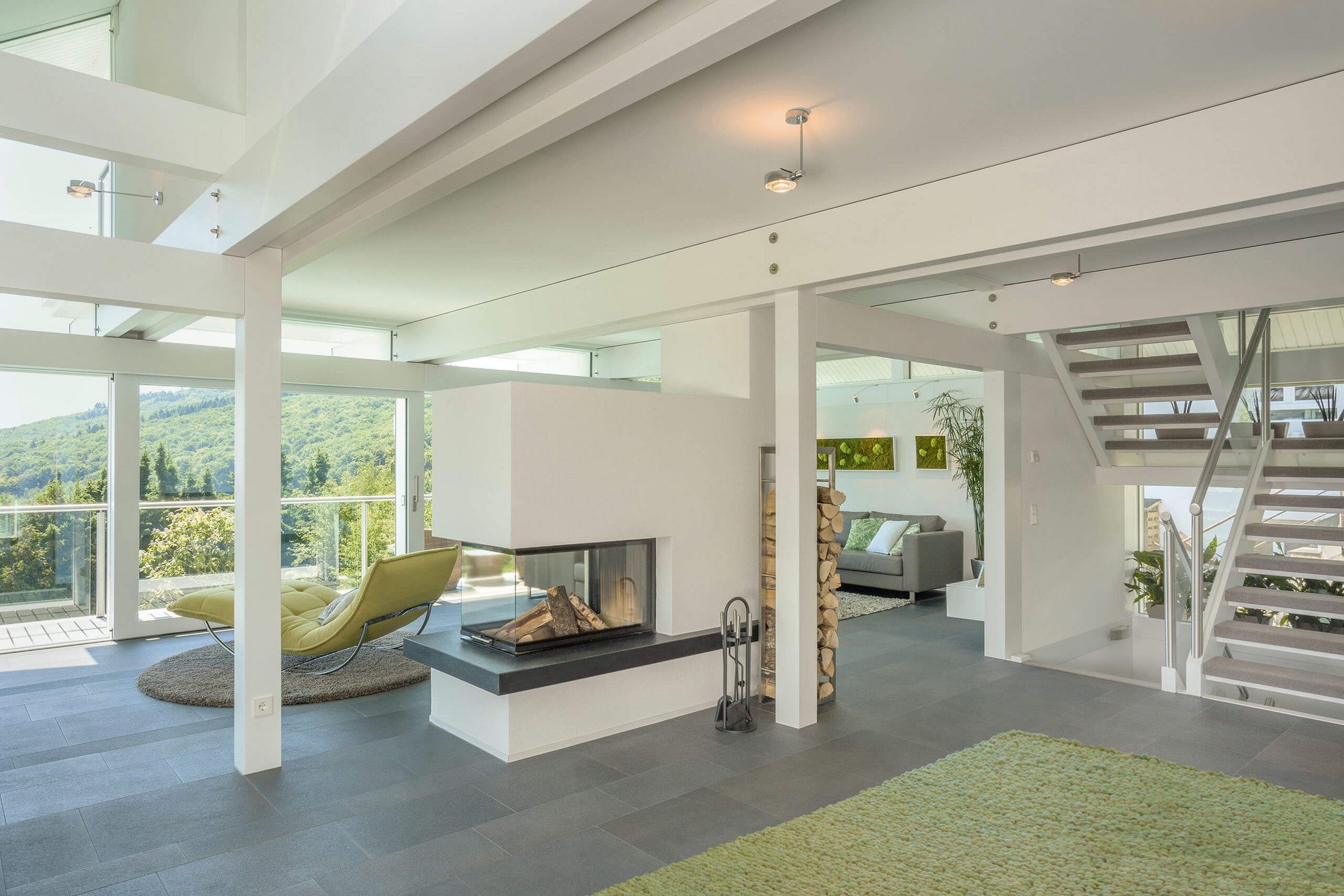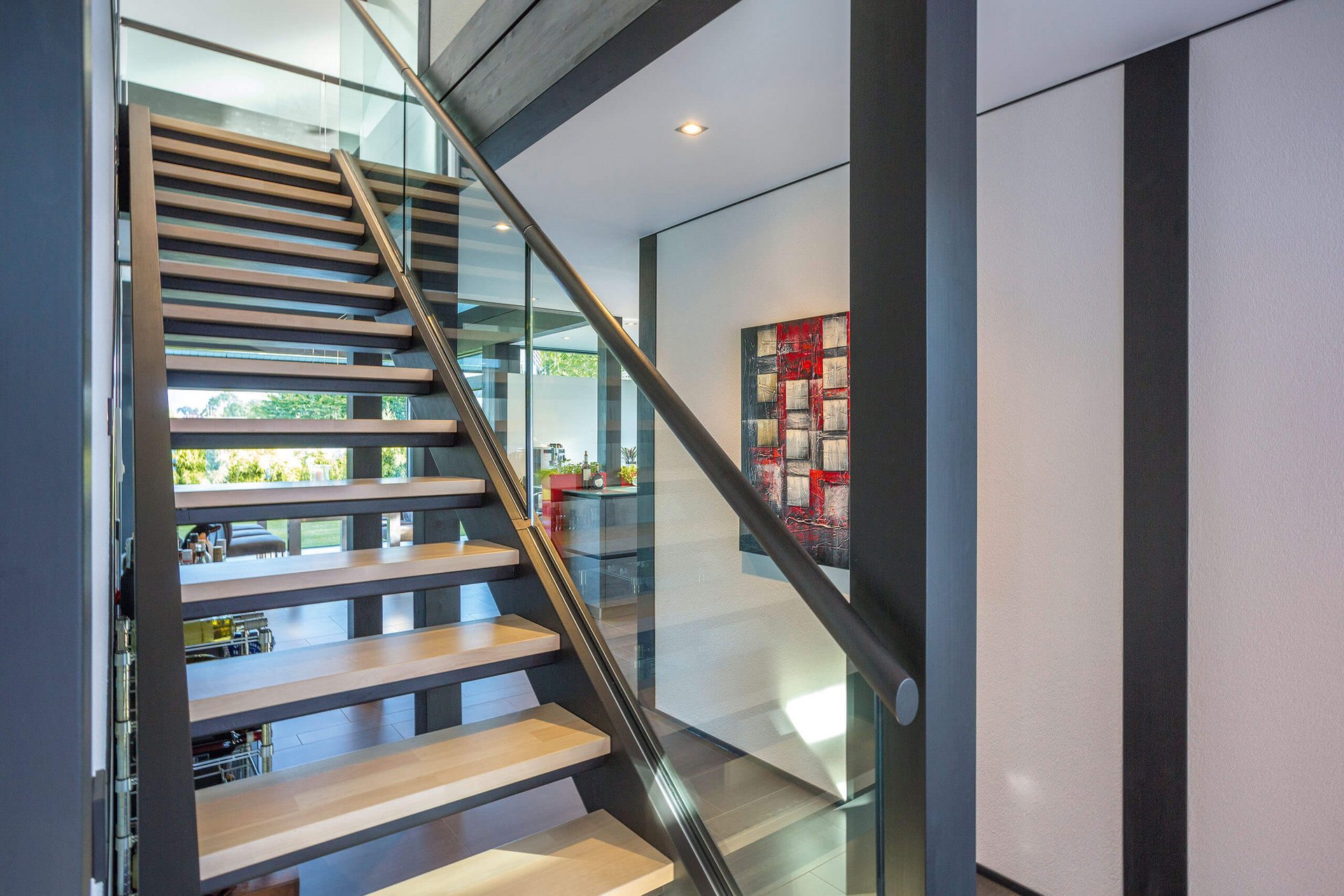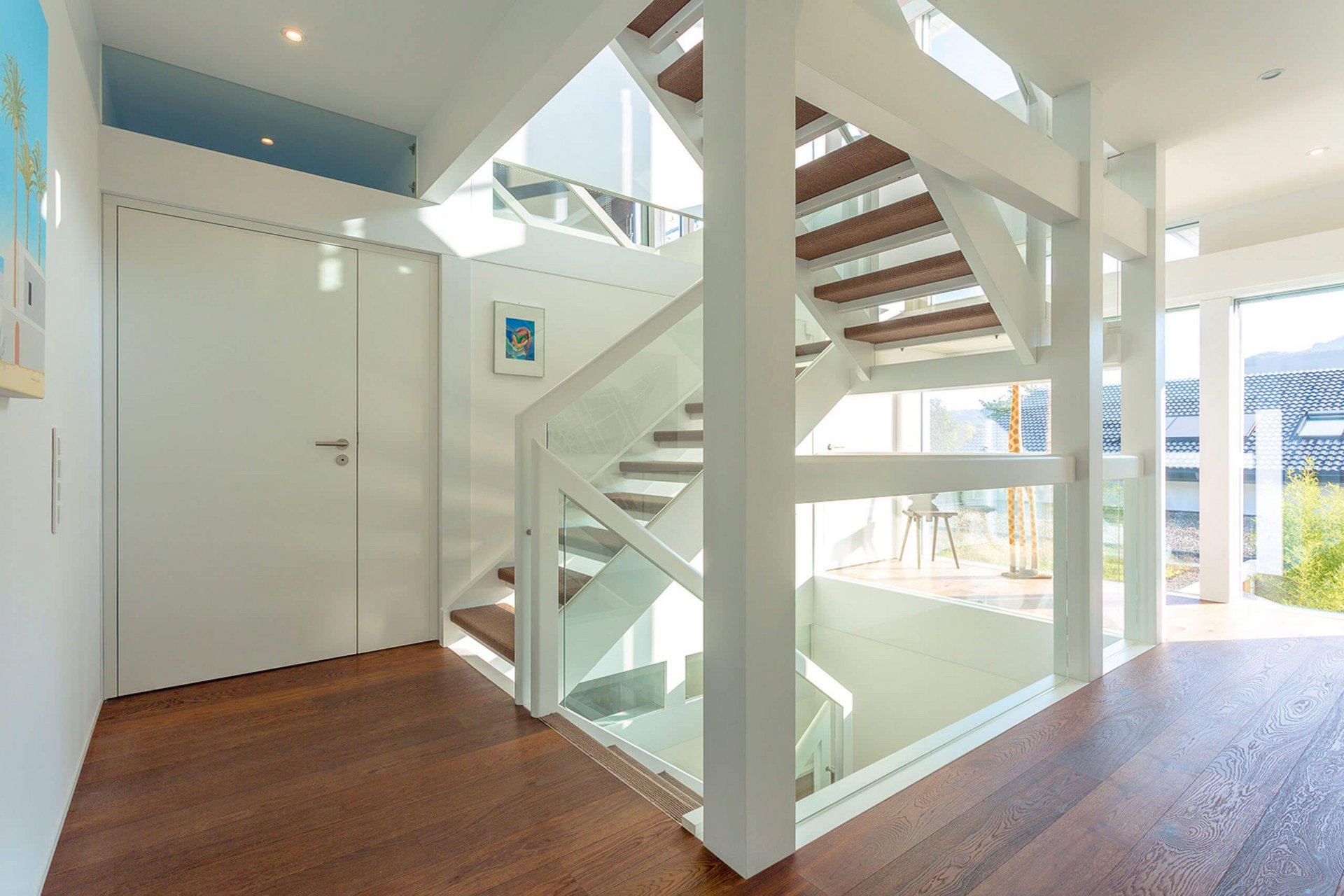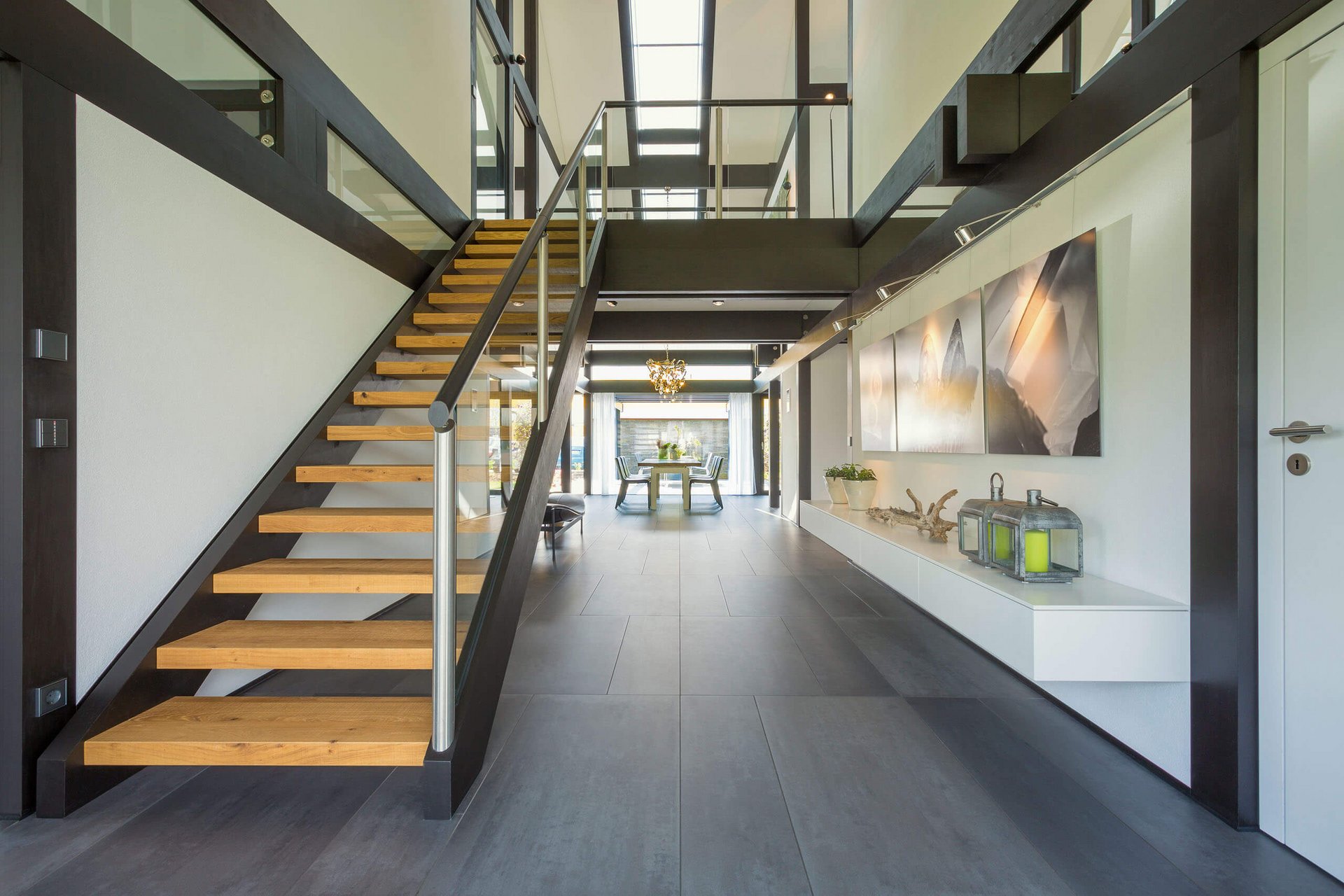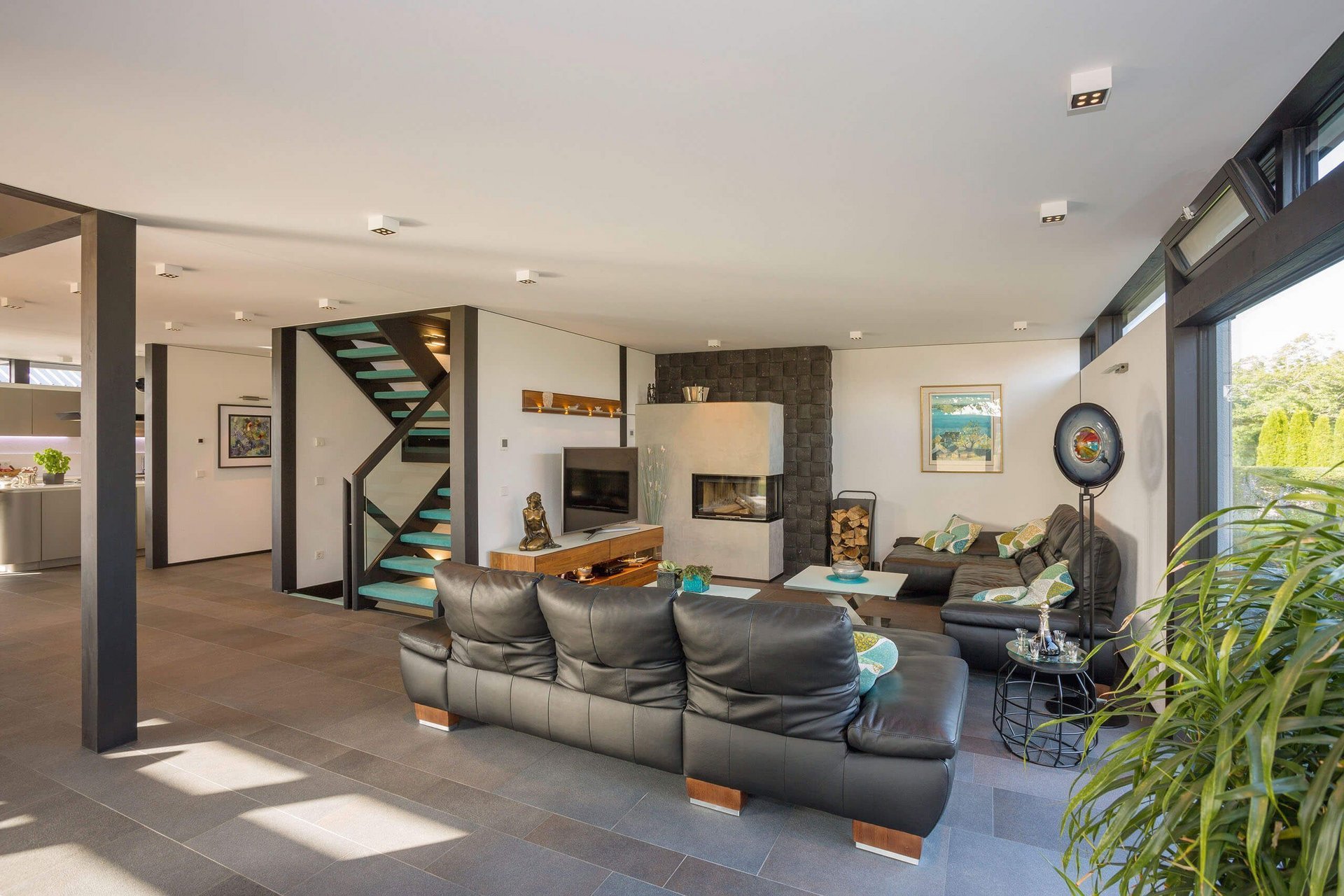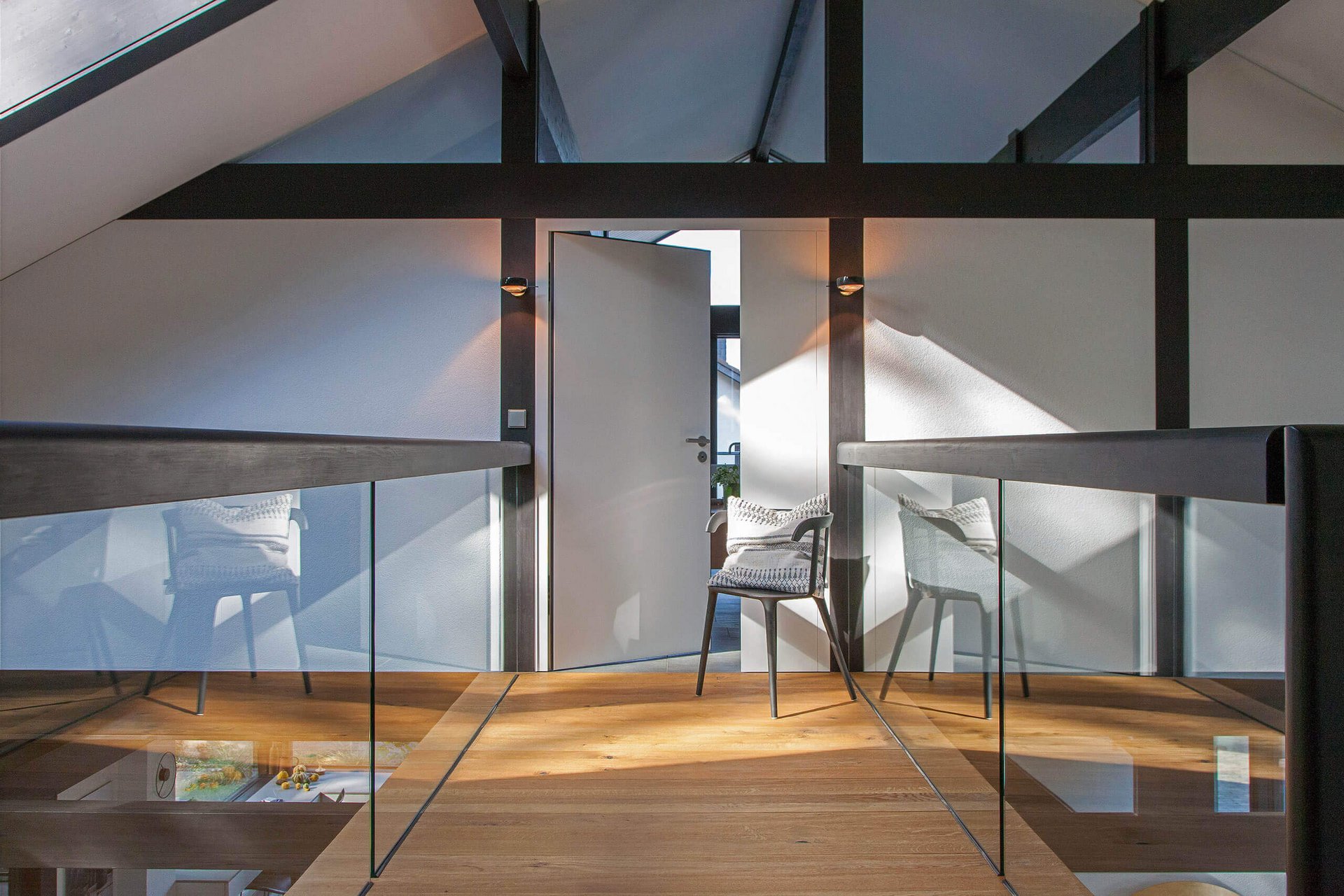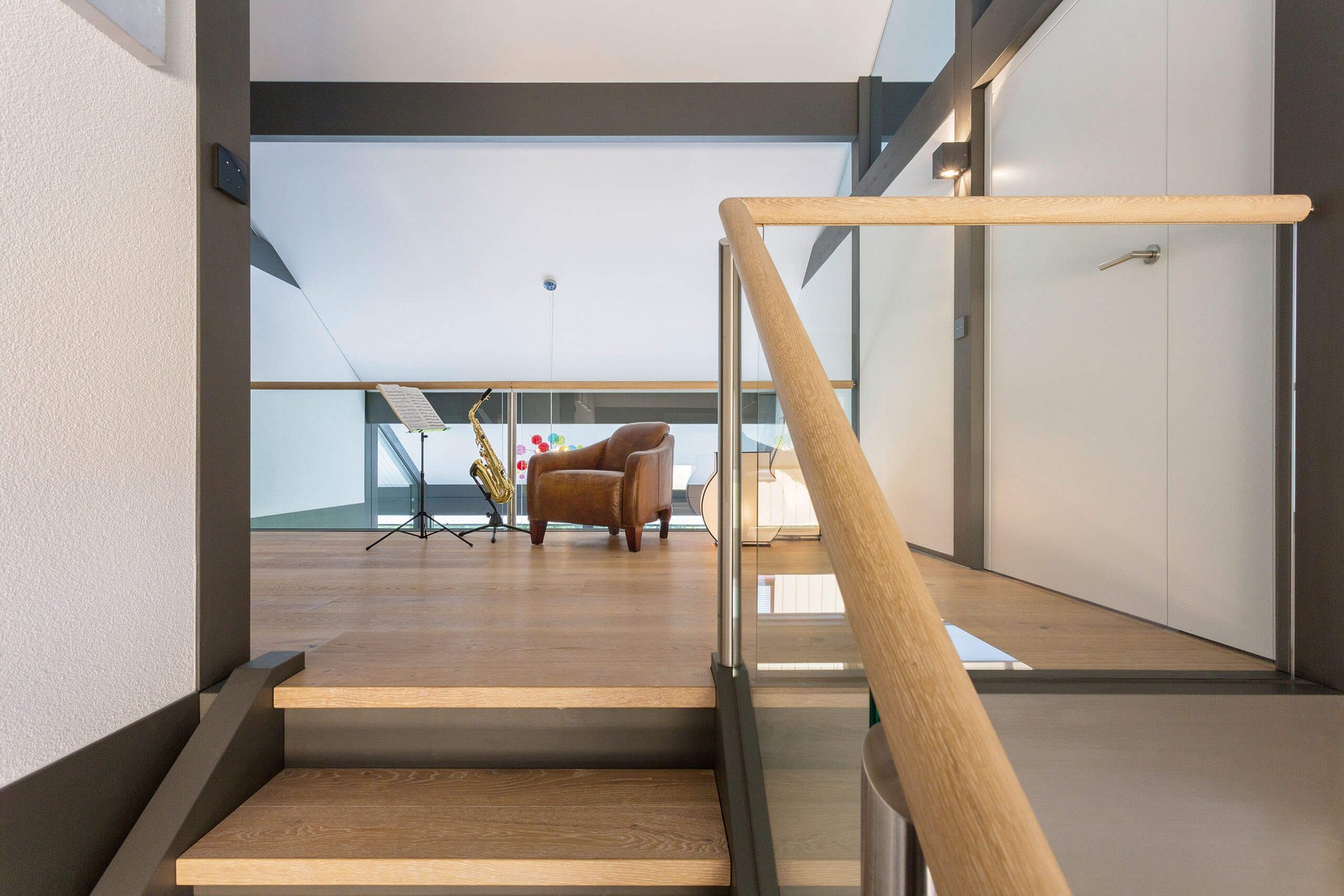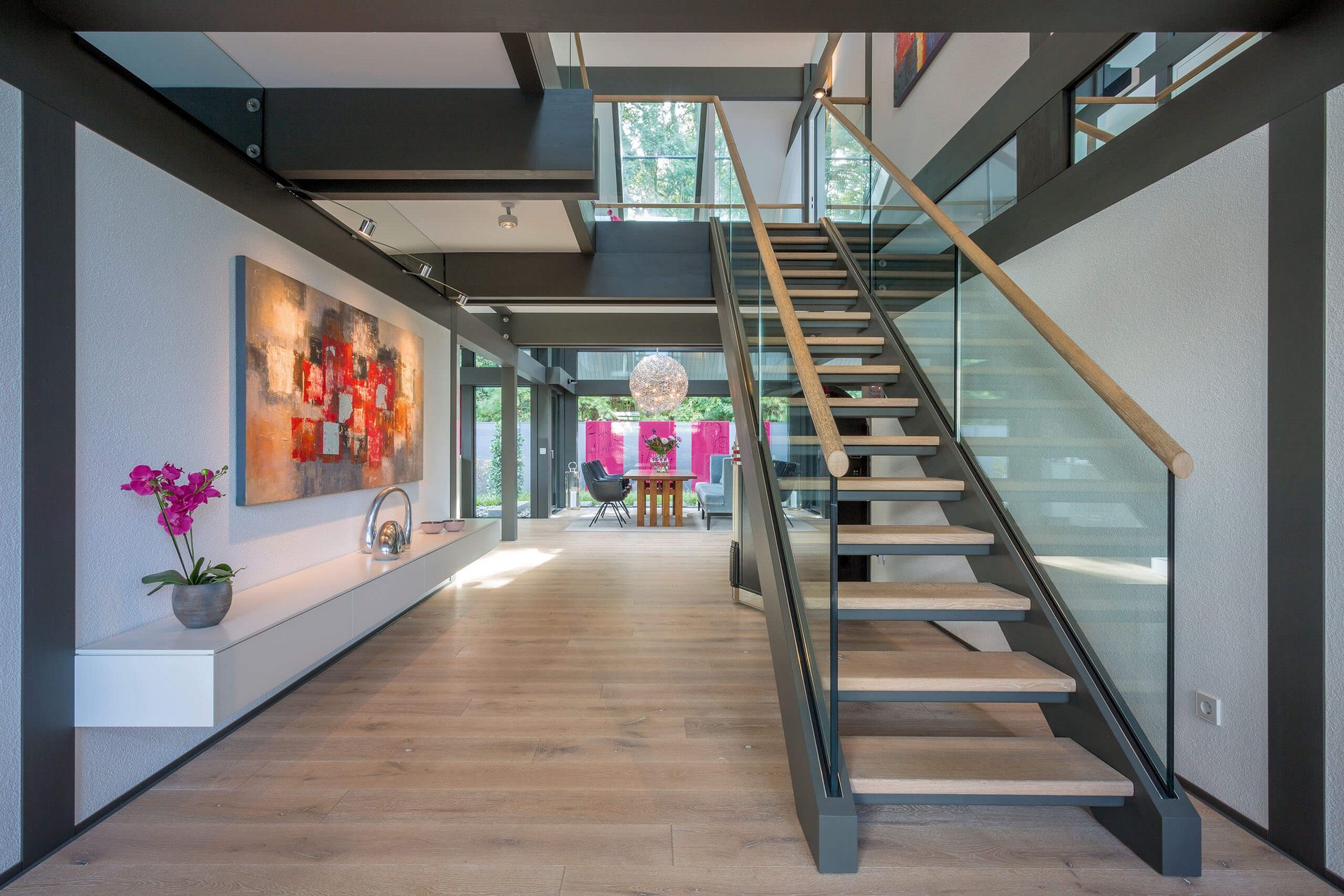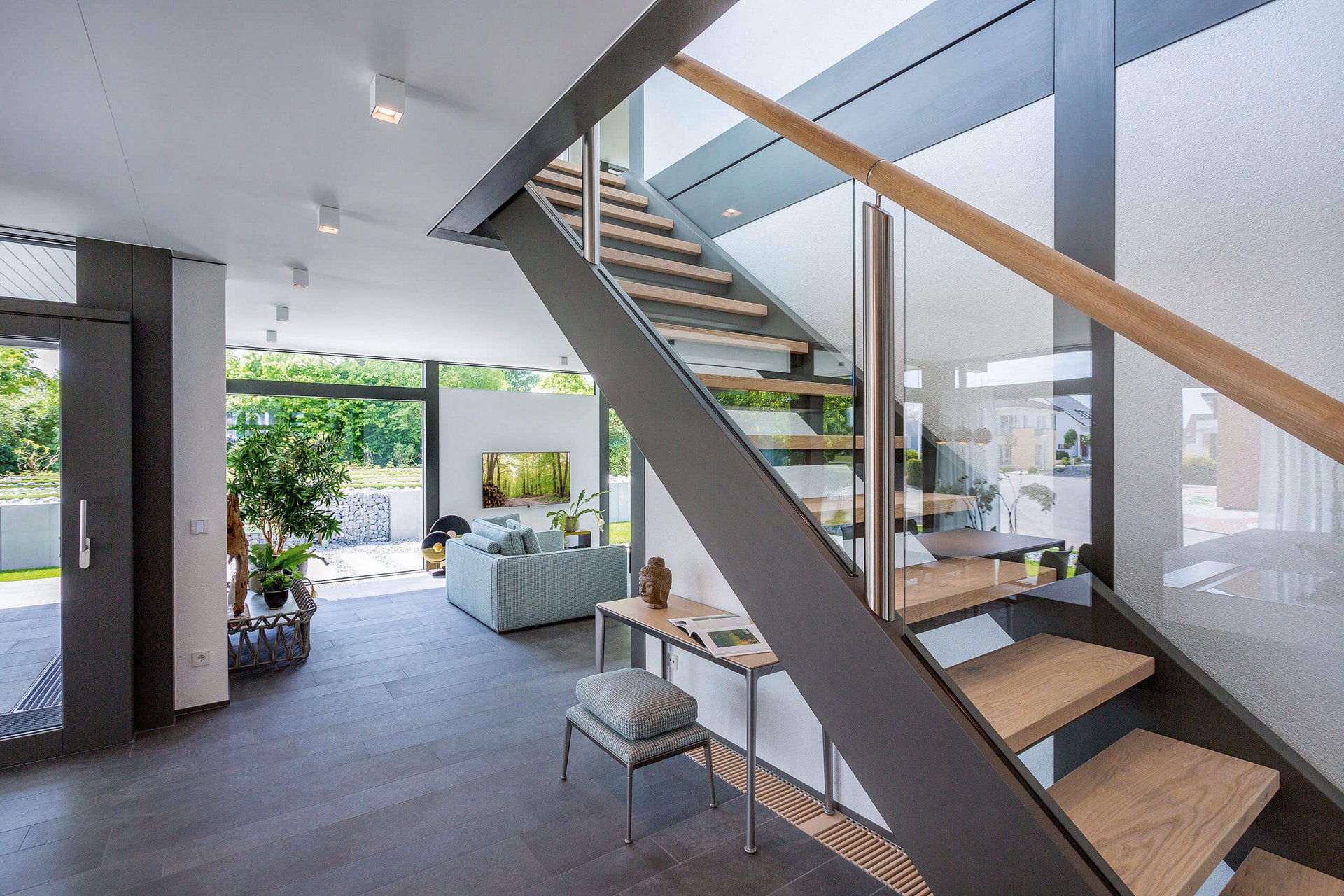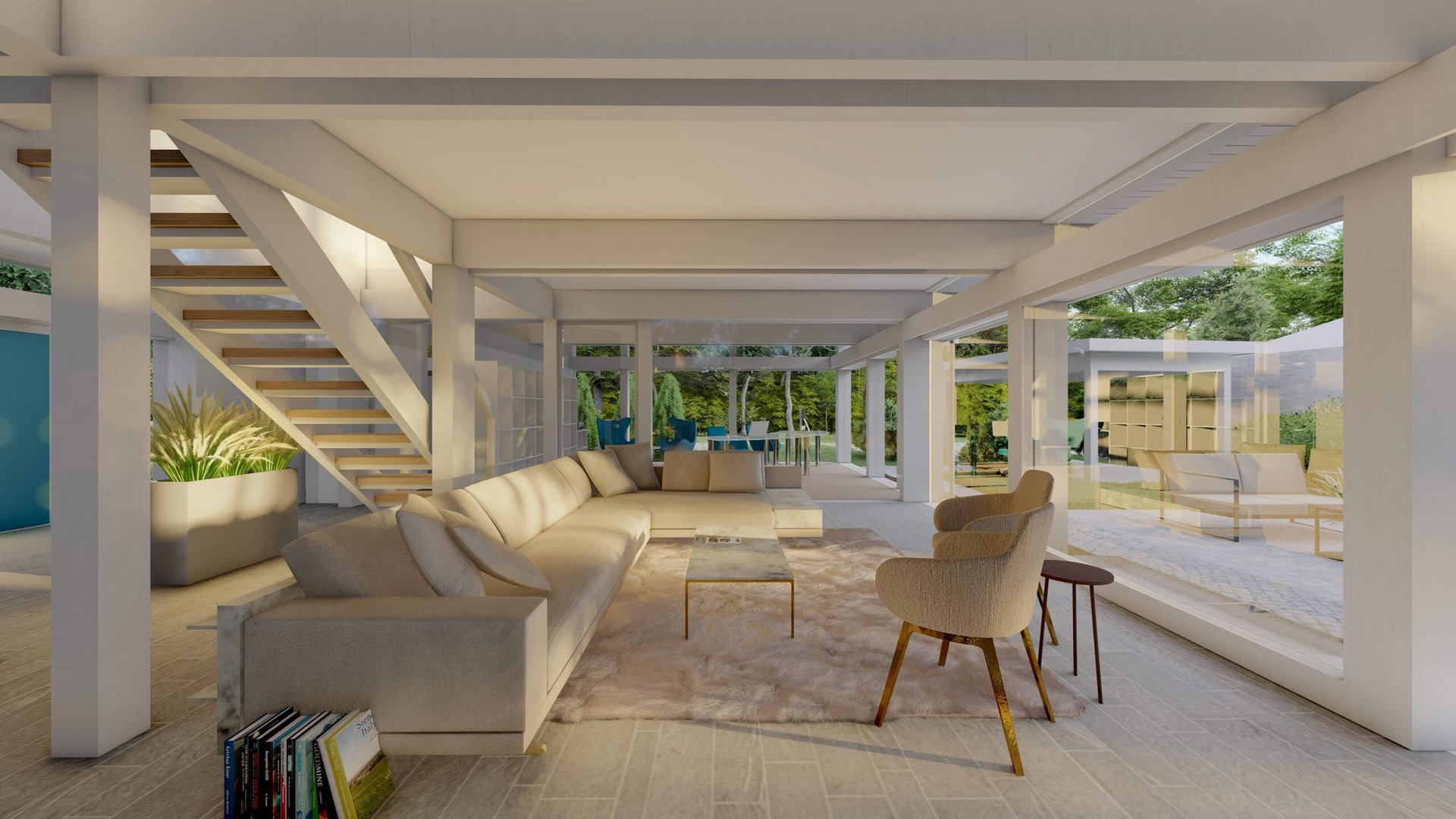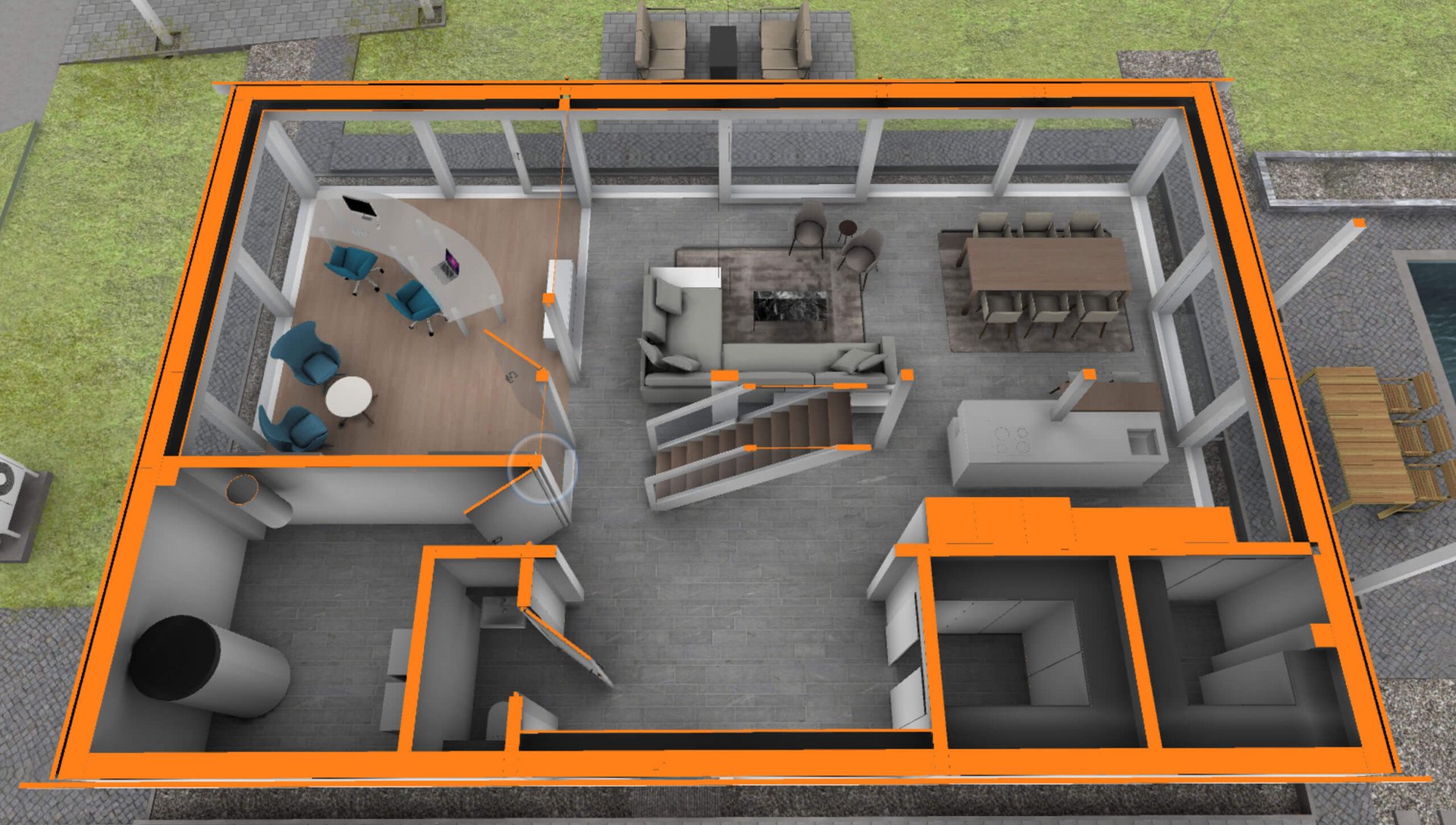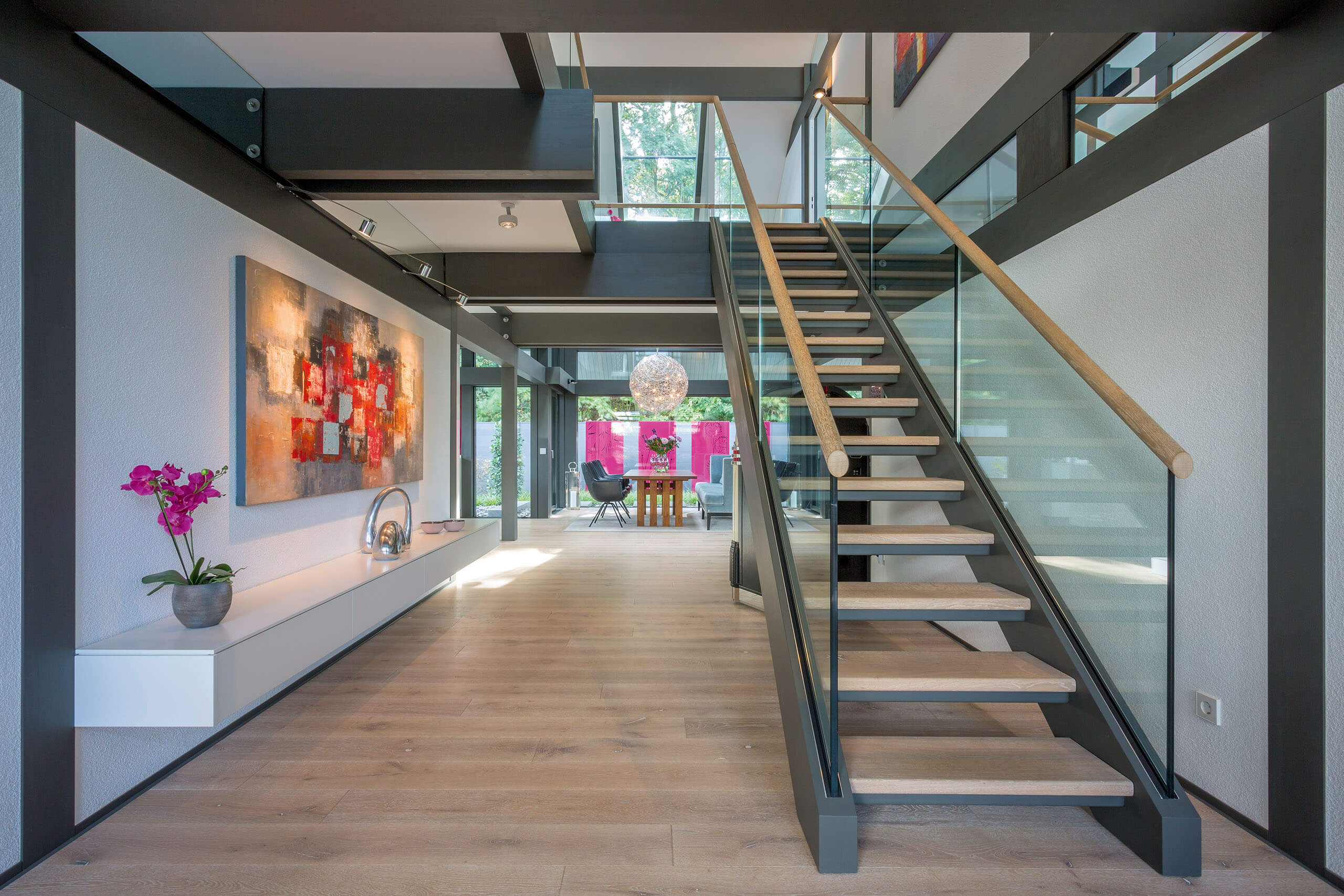
1. Floor plan: where do the stairs go?
Many factors should be taken into account when you plan your home: the layout of the rooms, the best type of floor covering, where the furniture will be placed. When planning your bespoke HUF house, the stairs should be given just as much consideration as all these other aspects. In connecting the ground floor with the first floor, a stairway can take on a role of quiet functionality or it can be an eye-catching focal point.
“The position of the stairs is determined at the beginning of the planning stage, since the design of the house will be strongly influenced by its positioning. The stairway is an architectural element and should highlight and augment the architecture of the house.” Alexander HUF, Architect.
In a classic approach, the stairway can be placed by the entrance as a functional, space saving option as can be seen in this HUF house Art 3.
In this flat-roofed, post and beam house, the stairway is a strong focal point since it is visible from the dining room. Through the openness of the floorplan, the stairs have been incorporated into the living space.
To highlight stairs as an eye-catching feature, they can be positioned to draw attention to themselves as a sculptural element or a furnishing accent. When this is the desired effect, the type of staircase incorporated plays an important role (see image 3). In our London showhouse, the broad sweeping stairway is a central part of the design, placed in the middle of the house, it balances a generous open gallery above and a comfortable spacious area below accented with a stylish chair.
For multi-family homes or homes partitioned into rental units, the stairway plays a different role. In this case, all parties in the various residential spaces access their apartment via the stairs. In this design, the stairway is enclosed in glass – an elegant, architecturally sophisticated solution.
During the design phase, an experienced HUF architect will advise you as to which stairway solution may work best for you and your floorplan.
2. The Right Type of Stairs
The direction of travel often determines the stairway style. If you have a vertical open space, often a single flight of stairs is best. A split stairway features a landing in the middle where you change the direction of travel or where you can take a quick break before continuing to climb the stairs. HUF houses do not use the more cramped option of a spiral staircase that winds down like a corkscrew around a central stairwell.
The HUF single-flight and split stairways always feature quality built, sturdy steps individually positioned, allowing you to look through your stairway. This creates a feeling of openness. They feature shatter proof glass along the side, topped with an ergonomically pleasing wooden handrail.
3. Stylish Steps
Once the right stairway is planned in the perfect position, the next option must be considered. Which floor finishing should the steps have? Should they be polished wood or carpeted, brightly or subtly coloured, and should they match the rest of the flooring? The steps and landing for your HUF house will feature quality materials, whatever you choose. Should you choose carpet to cover your stairs, the very same carpet can be extended throughout the first floor to create a harmonious look. Alternatively, you could opt to create a striking contrast by using a different material altogether.
Attention grabbing colour combinations are also possible, to reflect the personality and style of the owner and to give the house a character all its own. If a client chooses, the steps and landing could be made of oak or another type of wood of the client’s choice. The wood used here could be the same type of wood used throughout the house in a hard wood floor, creating a harmonious look throughout the home and a peacefully unified atmosphere.
4. What Is the Banister Infill Made Of?
In conventional homes, a banister is usually supported by wooden or steel uprights or by a type of fencing or netting. HUF Houses are distinctive in their openness. Thanks to an entirely glazed banister infill, clients enjoy clear, unobstructed views to their surroundings. In this way, the openness of the overall design is mimicked in the stairs, whose banister infill is made of safety glass. Clients can also choose to have a clamped glass infill, to create the effect of floating glass. Both versions allow for uninhibited views and support the feeling of openness.
5. Hold on Tight – The Handrail
Even if a stairway isn’t especially steep or dangerous, a handrail is a necessary part of every staircase and can be an attractive addition of the stairway design. Here too the client has numerous options of colour, shape and material. A rounded handrail of laminated wood compliments the stylish HUF banister. Through this combination of glass and wood, the completed stairway echoes the style and language of the glass and wood house.
Rounded handrails or stainless-steel options are among the various possibilities available on request. The handrail can be made to match the colour or the house or to match the type of wood of a hard wood floor.
6. Space Saver: Plan Stairs with a Tucked Away Storage Space
Do you need more storage space? In this example, the family has built a closet under the stairs. The clever solution offers storage space for a plethora of items while still being easily accessible. Thanks to the unobtrusive design, the sliding door concealing the well-integrated storage area is hardly noticeable.
7. Impressive Reception Halls: The Single-Flight Stairway
For floor plans with particularly spacious entrance areas, you can create an impressive Wow-effect with a single-flight stairway. In the HUF house ART 6 (left picture), the distinctly different reception hall welcomes residents and guests, leading them to the spacious gallery. The imposing staircase, whose steps match the wood of the hard wood floor, appears light and elegant due to the open steps and glass sides.
As a free-standing design feature, this stairway requires ample space to create this impressive effect. Other versions of the single-flight stairway which require less space by running flush against the wall can also achieve stunning results. This HUF house (right picture) built in the MODUM style demonstrates an elegant alternative.
8. Seeing is Believing
Will the stairway really look the way you have envisioned it? The computer-generated visualisation of your HUF house will give you a realistic and thorough impression of what you can expect your house to look like, both outside and inside. You will be able to view the design, the room layouts with furniture placement ideas, get a thorough understanding of the proportional sizes, and even view your future garden from your yet-to-be-built home. Using sophisticated computer modelling software, you will be able to see your planned staircase positioned in the home in the planning phase of your home design.
9. Quality That’s a Step Above – Custom Made Stairs from Our Own Expert Production
In technical jargon, a stairway is defined as an uninterrupted series of at least three steps that have an entry and exit step.
According the German building standard norms, the width of a stairway must also be at least 80 centimetres in a residential building. Furthermore, in Germany the width of the steps and the potential gradient of the stairway is fixed. This is to ensure the safety and comfort of the stairway, but the true test of a good stairway is the quality of its construction. Stability is key. With Every step on a well-built stairway, you should feel the sturdiness of the expert workmanship and the quiet result of masterfully constructed stairs. This is what you will find in your HUF HAUS stairs, where we use only the highest materials carefully crafted by experts.
HUF stairs are crafted under perfect conditions in our state-of-the-art production facility in Germany, using the latest in carpentry technology and old-world know how.
A tour of our world-class production facility will give you an idea of the exceptionally high quality that is standard for all of our materials and craftmanship.
